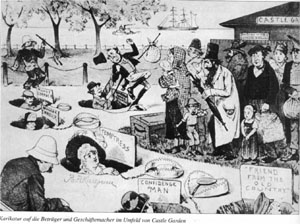Heinrich Lemcke, im Husumer Wochenblatt, Mai 1886: Abfertigung in Castle Garden:
„Auf ein gegebenes Zeichen öffnete sich mit einem Male die jenseits gelegene Pforte des Depots und nun zog ein Schwarm von über zwölfhundert Emigranten, denn so viele Zwischendecks-Passagiere hatte die ‚Rugia‘ überbracht, in die Riesen-Rotunde. – Der Nationalität nach waren die meisten Deutsche aber auch viele Österreicher, Ungarn, Schweizer, Schweden, Norweger und Dänen erblickte ich. Im Gänsemarsch mit Kisten, Kasten und Bündel, ja oftmals mit Säuglingen bepackt, zogen sie an den diversen Bureaus vorbei, dann lagerte sich Alles. […]
An einem Pfeiler sahen wir eine deutsche Familie, fast einen ganzen Stammbaum bildend. Fünfzehn Personen waren es – das zählte! – Dort in der Ecke erblickten wir ein blutjunges, hübsches Mädchen, eine Waise, kaum 16 Jahre alt, die mutterseelenallein die Reise übers Weltmeer machte; - hier sehen wir eine Gruppe vom Schicksal und Nahrungssorgen heimgesuchter, abgemagerter Männer, - dort eine Anzahl schreiender Säuglinge […], hier ein Mann mit grauem Haar, anscheinend ein Fünfziger, dessen sorgenvoller Blick verräth, dass er voll Bangigkeit der Zukunft entgegenblickt – dort ein Allerwelts-Schneider, der seinen Schiffsfreunden, lauter jungen, flaumbärtigen Männern, einen Vortrag über die amerikanische Kunst, reich zu werden, hält.“





Presentation
The first source is a letter that was printed in “The Husumer Weekly” in 1896. “The Husumer Weekly” used to print letters from emigrants to tell the people at home how it was to emigrate. The report shows how different the emigrants were.
The cartoon shows tricksters and profiteers at Castle Garden. Built in 1811 as a fort at the southern tip of Manhattan, it was rebuilt in 1840 and used as a theatre. From 1855 to 1890, the Castle was America's first official immigration center; around seven million people arrived there. Castle Garden was succeeded by Ellis Island in 1892.